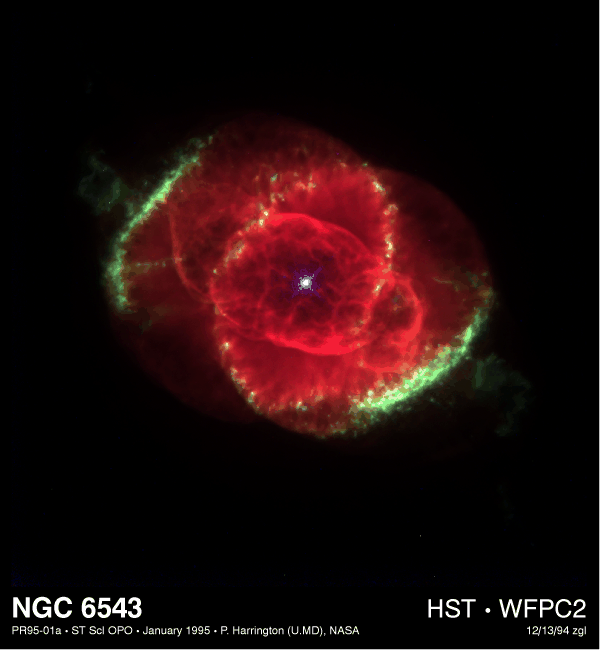
|
End of a Star's Life:
| Readings: Schneider & Arny: Unit 66 |
| (Audio Lecture) |
For stars less than about 25 solar masses the end of their lives is to evolve to white dwarfs after substantial mass loss. Due to atomic structure limits, all white dwarfs must mass less than the Chandrasekhar limit. If their initial mass is more than the Chandrasekhar limit, then they must lose their envelopes during their planetary nebula phase till they are below this mass limit. An example of this is the Cat's Eye Nebula shown below:

At what stage a star leaves the AGB (Asymptotic Giant Branch) and becomes a white dwarf depends on how fast it runs out of fuel in its core. Higher mass stars will switch from helium to carbon burning and extend their lifetimes. Even higher mass stars will burn neon after carbon is used up. However, once iron is reached, fusion is halted since iron is so tightly bound that no energy can be extracted by fusion. Iron can fuse, but it absorbs energy in the process and the core temperature drops.
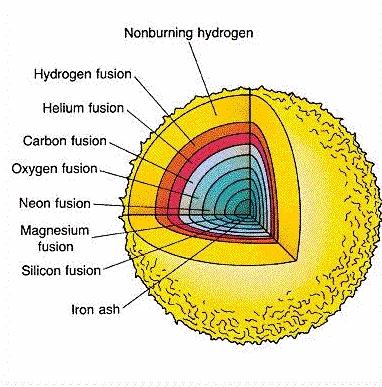
After evolving to white dwarfs, stars with original masses less than 25 solar masses slowly cool to become black dwarfs and suffer heat death.
Stars greater than 25 solar masses undergo a more violent end to their lives. Carbon core burning lasts for 600 years for a star of this size. Neon burning for 1 year, oxygen burning about 6 months (i.e. very fast on astronomical timescales). At 3 billion degrees, the core can fuse silicon nuclei into iron and the entire core supply is used up in one day.
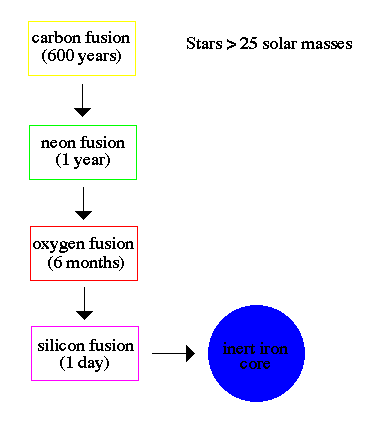
An inert iron core builds up at this time where successive layers above the core consume the remaining fuel of lighter nuclei in the core. The core is about the size of the Earth, compressed to extreme densities and near the Chandrasekhar limit. The outer regions of the star have expanded to fill a volume as large as Jupiter's orbit from the Sun. Since iron does not act as a fuel, the burning stops.
The sudden stoppage of energy generation causes the core to collapse and the outer layers of the star to fall onto the core. The infalling layers collapse so fast that they `bounce' off the iron core at close to the speed of light. The rebound causes the star to explode as a supernova.
The energy released during this explosion is so immense that the star will out shine an entire galaxy for a few days. Supernova can be seen in nearby galaxies, about one every 100 years (therefore, if you survey 100 galaxies per year you expect to see at least one supernova a year). One such supernova (1991T) is shown below in the galaxy M51.
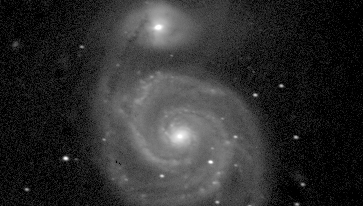
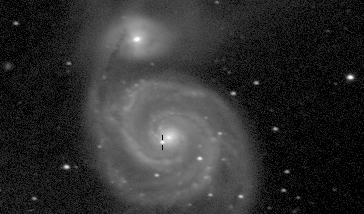
Supernova Core Explosion:
Once the silicon burning phase has produced an iron core the fate of the star is sealed. Since iron will not fuse to produce more energy, energy is lost by the productions of neutrinos through a variety of nuclear reactions. Neutrinos, which interact very weakly with matter, immediately leave the core taking energy with them. The core contracts and the star titers on the edge of oblivion.
As the core shrinks, it increases in density. Electrons are forced to combine with protons to make neutrons and more neutrinos, called neutronization. The core cools more, and becomes an extremely rigid form of matter. This entire process only takes 1/4 of a second.
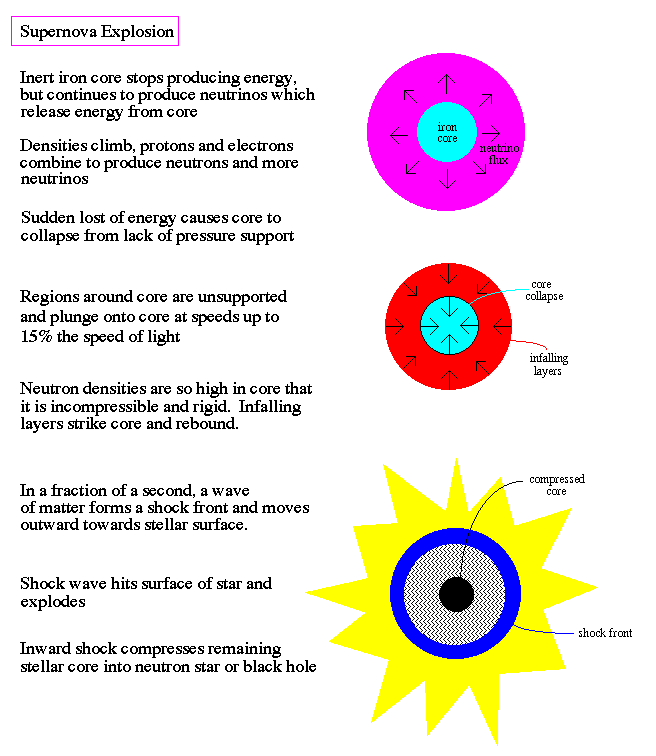
With a loss of pressure from core, the unsupported regions surrounding the core plunge inward at velocities up to 100,000 km/s. The material crashes into the now-rigid core, enormous temperatures and pressures build up, and the layers bounce upward. A shock wave forms, which accelerates and, within a few hours, explodes from the surface of the star rushing outward at thousands of km/sec.
This entire process happens so fast that we can only follow it using supercomputer simulations. Maps of density and flow show the details in regions where observations can not be made.
As the outer layers are blasted into space, the luminosity of the dying star increases by a factor of 108 or 20 magnitudes. In 1987, a supernova exploded in our nearest neighbor galaxy. That supernova, designated SN1987A (the first one discovered in 1987) was visible to the naked eye, rising to a maximum brightness 85 days after detonation with a slow decline over the next 2 years. The light curve for SN1987A is shown below:
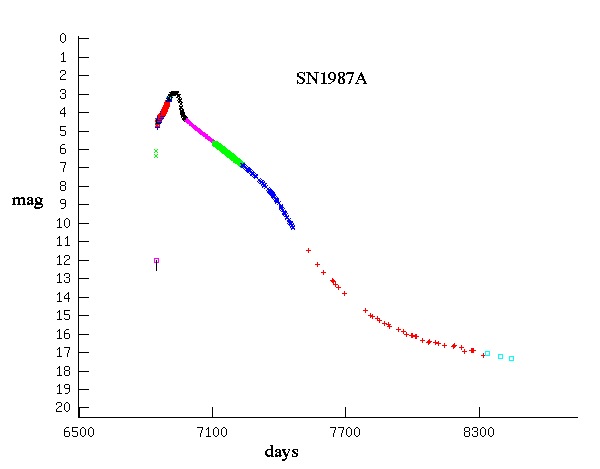
Although a supernova is extremely bright, only 1% of its energy is released as optical light. The rest was released as neutrinos and kinetic energy to explode the star. Most of the initial luminosity is the shell of the star expanding outward and cooling. After a few hundred days, this shell of expanding gas has cooled to be almost invisible and the light we see at this point is due to the radioactive decay of nickel and cobalt produced by nucleosynthesis during the explosion.
Neutrinos and Gravity Waves:
Supernova are the most energetic events in the Universe and provide an opportunity to observe two very elusive phenomena, neutrinos and gravity waves.
The collapse of a supernova core produces a flood of those very strange particles, neutrinos. Neutrinos interact very weakly with matter. Under most conditions, matter is transparent to neutrinos. During the high densities of a supernova core collapse, some of the neutrinos provide the pulse to starts the outward moving shock wave. But most of the neutrinos zip out of the supernova core. Thus, when a supernova explodes, huge numbers of neutrinos pour into space, streaming across the Galaxy passing through dust, gas, nebula unhindered. Even if the supernova is obscured, the neutrinos will rain down on the Earth.
However, because neutrinos are weakly interacting, they are also just as difficult to detect. Our best neutrino `telescopes' are large tanks of water buried deep underground such as the Super Kamiokande in Japan. Water contains lots of protons in the form of hydrogen atoms. Neutrinos from a supernova explosion travel at or very near the speed of light and carry a lot of energy. On rare occasions, a neutrino will hit a proton in the tank of water (the more water, the greater the chance). This collision will produce a positron which recoils with such high speed that it emits a brief flash of light known as Cerenkov radiation. The detector tank of water is buried deep in the Earth to eliminate cosmic rays and other interactions that would distort the detection of the neutrinos. Only neutrinos can reach to such depths.
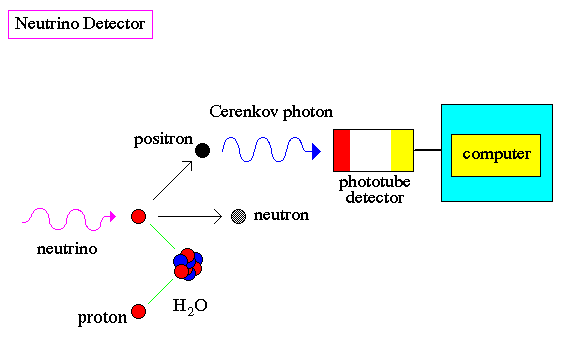
The supernova SN1987A was the first recorded neutrino detection of an astronomical event (most neutrinos detected are from the Sun). Twelve neutrinos were detected 3 hours after the supernova was seen in the optical. The neutrino detections also give us valuable information on the neutrino itself. Until recently, we did not know if the neutrino has zero mass (like the photon and, therefore, travels at the speed of light) or if it has a small mass and must travel less than the speed of light. If neutrinos are massless, then they would arrive at the Earth at the same time. The more massive the neutrino, the more spread out their arrival times. The results from these experiments showed that the neutrino has a very small mass, a surprise to the world of particle physics.
Another exotic technique to study supernovae is through the use of gravitational radiation. During the core collapse of the supernova, vast amounts of matter are moved about at enormous speeds. The dense mass is surrounded by a strong gravitational field. Einstein's general theory of relativity describes gravity as curves in the fabric of space. Vigorous changes in gravity will produce `ripples' in the geometry of space, and these ripples can propagate outward at the speed of light, called gravity waves.
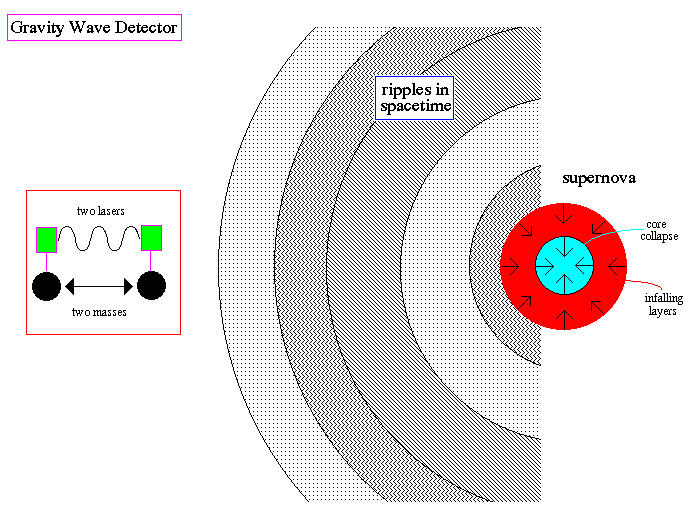
Gravity waves can be detected by the effects they have on other masses. For example, two masses will vibrate when a gravity wave passes, so sensitive measurements of their motion with lasers will detect the motion. Currently our technology is unable to detect gravity waves, but a new system (LIGO) is currently under construction for use at the turn of the century.
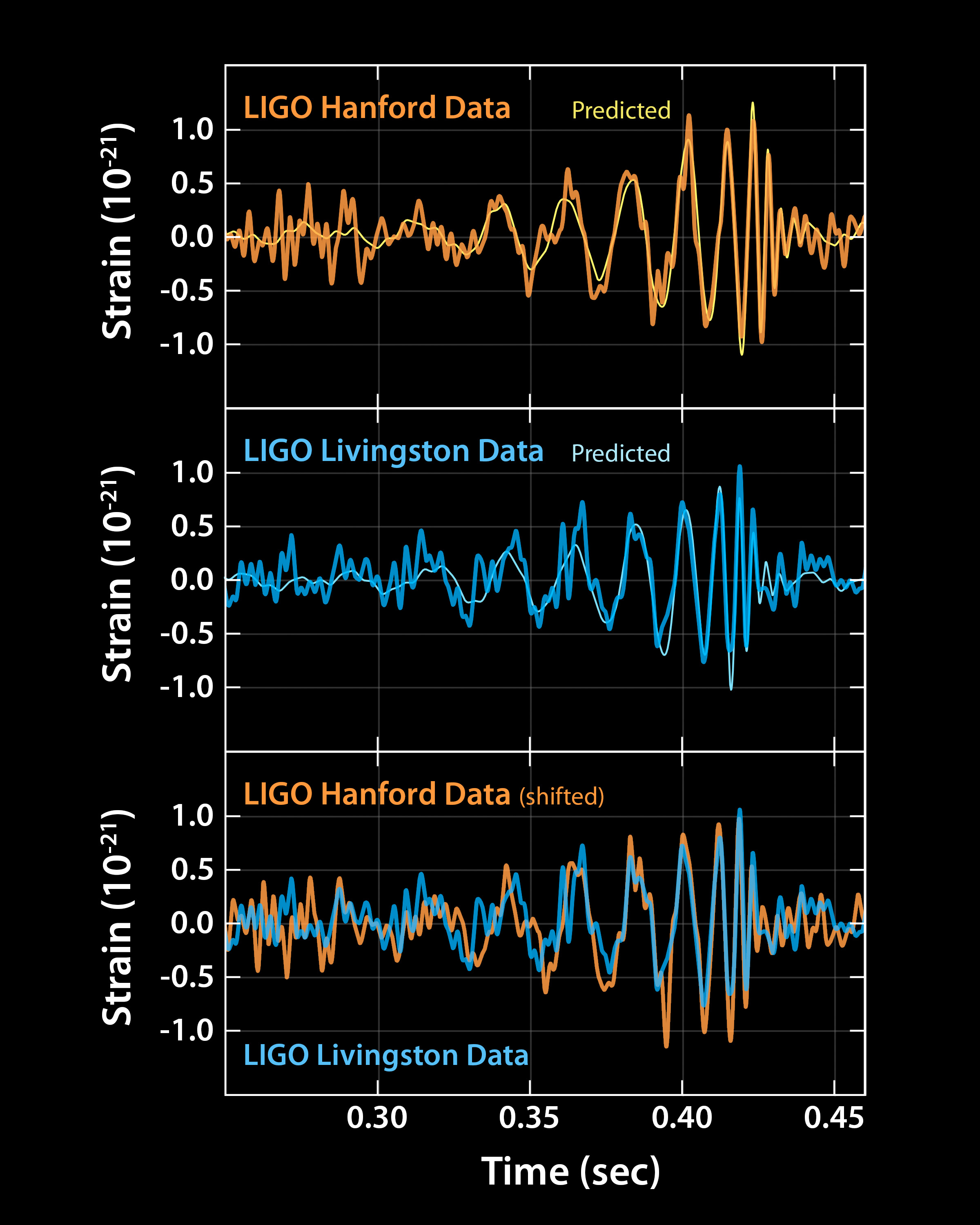
Nucleosynthesis:
There are over 100 naturally occurring elements in the Universe and classification makes up the periodic table. One of the great successes of stellar evolution theory was the explanation of the origin of all these elements. Some of the elements were formed when the Universe was very young. The era immediately after the Big Bang was a time with matter was densely packed and temperatures were high (ten's of millions of degrees). Fusion in the early Universe produced hydrogen, helium, lithium, beryllium and boron, the first 5 elements in the periodic table.
Other elements, from carbon to iron, were formed by fusion reactions in the cores of stars. The fusion process produces energy, which keeps the temperature of a stellar core high to keep the reaction rates high. The fusing of new elements is balanced by the destruction of nuclei by high energy gamma-rays. Gamma-rays in a stellar core are capable of disrupting nuclei, emitting free protons and neutrons. If the reaction rates are high, then a net flux of energy is produced.
Fusion of elements with mass numbers (the number of protons and neutrons) greater than 26 uses up more energy than is produced by the reaction. Thus, elements heavier than iron cannot be fuel sources in stars. And, likewise, elements heavier than iron are not produced in stars, so what is their origin?
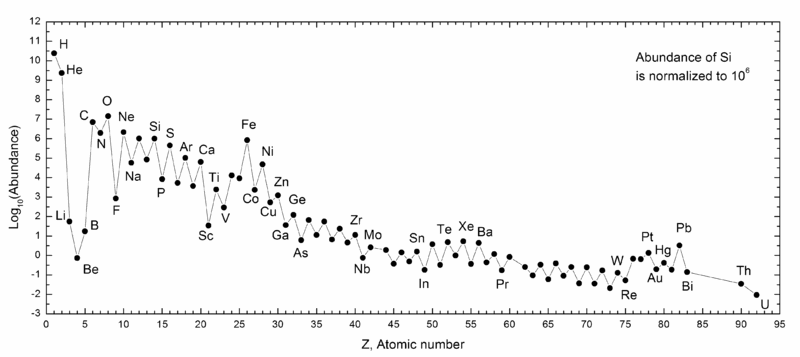
The construction of elements heavier than iron involves neutron capture. A nuclei can capture or fuse with a neutron because the neutron is electrically neutral and, therefore, not repulsed like the proton. In everyday life, free neutrons are rare because they have short half-life's before they radioactively decay. Each neutron capture produces an isotope, some are stable, some are unstable. Unstable isotopes will decay by emitting an electron and a neutrino to make a new element.
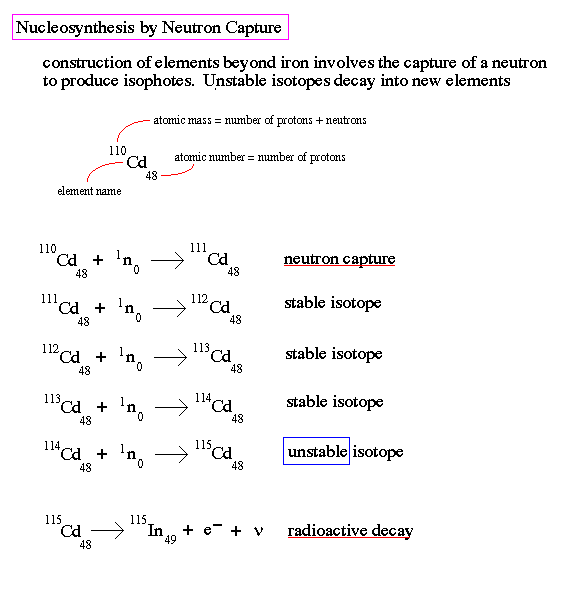
Neutron capture can happen by two methods, the s and r-processes, where s and r stand for slow and rapid. The s-process happens in the inert carbon core of a star, the slow capture of neutrons. The s-process works as long as the decay time for unstable isotopes is longer than the capture time. Up to the element bismuth (atomic number 83), the s-process works, but above this point the more massive nuclei that can be built from bismuth are unstable.
The second process, the r-process, is what is used to produce very heavy, neutron rich nuclei. Here the capture of neutrons happens in such a dense environment that the unstable isotopes do not have time to decay. The high density of neutrons needed is only found during a supernova explosion and, thus, all the heavy elements in the Universe (radium, uranium and plutonium) are produced this way. The supernova explosion also has the side benefit of propelling the new created elements into space to seed molecular clouds which will form new stars and solar systems.

|
|

|